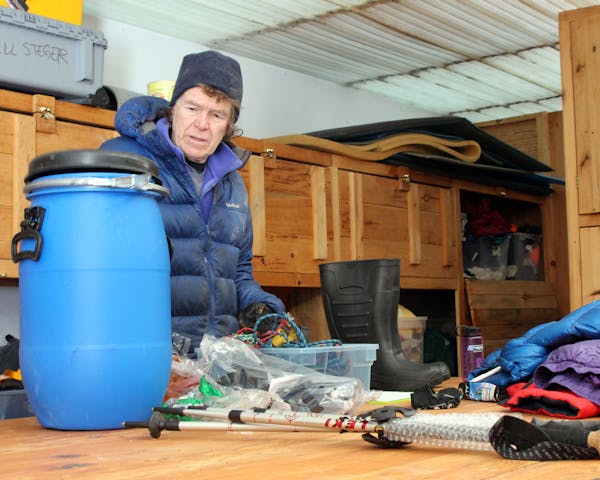Will Steger's strategy for success begins with organizing his Canadian Arctic expedition in meticulous detail, especially regarding equipment weight. His handwritten checklist (shown) is from two of his journal entries for his upcoming solo. The list offers a glimpse of just the gear he'll take. Items range in size from a canoe sled to tiny O-rings for a stove. However, this expedition straddles two seasons and requires extra: outer gear for deep winter, and water gear for spring temperatures when river ice becomes thin and can give way beneath human weight. In another list, he charted food and fuel rations to precise ounces. He also assigned exact amounts for the start of the expedition plus two resupplies during his journey. The total payload of his sled, gear, food and fuel will weigh in at about 220 pounds.
Insulated top, insulated bottom
Steger has enough clothing so that in the coldest situation he would wear everything he packed from an insulated top and bottom underneath to a large outer storm parka.
Pairs of socks
While Steger doesn't carry unnecessary weight, spare items such as dry socks are important. His most crucial supplies and their backups are stored apart from each other to prevent losing both in a mishap.
Journal
A journal is Steger's only book on an expedition other than spares stored for resupply. He said one book's weight in food could carry a person for three days. But beyond weight, thought-provoking reading isn't relevant to him in the wilderness.
Extra O-rings
O-rings are part of a small 1½-pound repair pack used to maintain his stove. Steger also carries a backup stove with interchangeable parts.
Extra ski bindings and screws
Steger estimated that about half his travel during an expedition is on skis. Extra ski bindings and screws are important to his progress if the originals give out.
Inner and outer sleeping bags
This setup offers a layer of insulation between them. Steger will also wrap a bivy sack around both bags and place a down-filled air mattress on the ground.
Boot spikes
Dressing for multiple seasons requires a variety of footwear: boot spikes, water shoes, mukluks and rubber boots four times his normal size to accommodate layers of felt liners and socks.
Satellite phone
Expedition electronics include a "sat" phone for emergencies. Steger uses solar technology to recharge power, though it has disadvantages. Cords and connectors don't always work in extreme conditions, so he carries a few AA batteries for backup.
Compass, GPS, maps
Along with matches, a knife and paper maps, Steger said a compass is the most important gear in his pack. A global positioning system, programmed with maps is helpful, but he wouldn't solely rely on it in case the electronics fail.
Dry suit
A dry suit and other water gear weigh about 10 pounds. It's more than much of the other equipment, but essential for safety should Steger become immersed in water.
Scott Stowell
Coyotes' move to Salt Lake City elicits opposing responses in 2 cities
Phillies' Spencer Turnbull has no-hit bid through 6 innings vs. White Sox

